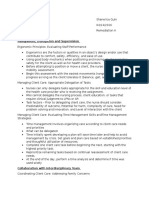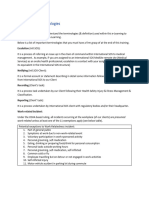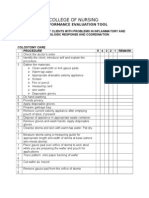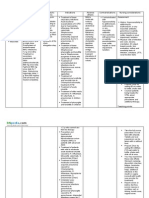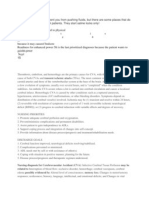Risk
Risk
Uploaded by
Henry Roque TagalagCopyright:
Available Formats
Risk
Risk
Uploaded by
Henry Roque TagalagOriginal Description:
Copyright
Available Formats
Share this document
Did you find this document useful?
Is this content inappropriate?
Copyright:
Available Formats
Risk
Risk
Uploaded by
Henry Roque TagalagCopyright:
Available Formats
Risk For Injury
CUES
NURSING DIAGNOSIS
SCIENTIFIC EXPLANATION
PLANNING
SELECTED INTERVENTION
IMPLEMENTED INTERVENTIONS
RATIONALE
EVALUATION
OBJECTIVE: -Needs assistance in ambulation -Headache -dizziness -limited motion -feeling of warm specially in the eye -VS taken as follows: T-37 C RR-28 cpm BP-150/100 mmhg
Risk for injury r/t multiple factors (Headache, dizziness, limited motion, feeling of warm specially in the eye, V/S T-37 c, RR- 28 cpm, BP150/100 mmhg)
The Increase o f BP and RR will result to hypertension which may affect the clients lost of balance, in relation to limitation of movements the client is unable to gain his balance and protect his self that leads to possible injury.
Short term Goal: At the end of Nursing intervention, the client will be free from any signs of injury. Long Term Goal: after nursing intervention the risk factors of client from pain will be lessen. After nursing intervention , the client will verbalized understanding of individual factors that may contribute to possibility of injury.
Assess general status of the client Assess mood coping abilities, personality style that may result in carelessness Assess environmental factors that may lead to injury Promoting clients Safety by: Monitoring V/S Providing materials for injury prevention
Assessed general status of the client. Assessed mood coping abilities, personality style that may result in carelessness. Assessed environmental factors that may lead to injury. Promoted clients Safety by: Monitored V/S Provided materials for injury prevention
To determined clients condition that may cause injury To determine the level of cooperation To determine causes of injury To lessen the risk for injury, safe environment and Promote clients comfort.
GOAL: The client was free of any signs of injury.
You might also like
- NURSING CARE PLAN On LeptospirosisDocument8 pagesNURSING CARE PLAN On LeptospirosisRosalie Valdez Espiritu78% (9)
- NCP-Risk For InjuryDocument1 pageNCP-Risk For InjuryLave Majorenos80% (10)
- Six Phases of The Nursing ProcessDocument4 pagesSix Phases of The Nursing ProcessJan Jamison Zulueta100% (4)
- Case Study RheumaticDocument46 pagesCase Study RheumaticJill Anne Balderosa91% (11)
- Nursing Minimum Data Set SystemDocument4 pagesNursing Minimum Data Set SystemHenry Roque Tagalag100% (3)
- NCP Intra FinalDocument7 pagesNCP Intra FinalRoxanne Ganayo ClaverNo ratings yet
- SafetyDocument16 pagesSafetyRn nadeenNo ratings yet
- Patient Safety PlanDocument4 pagesPatient Safety PlanDhananjay SainiNo ratings yet
- U04a1 - Patient Fall Reduction Executive SummaryDocument11 pagesU04a1 - Patient Fall Reduction Executive SummaryTawana CherryNo ratings yet
- Prelims SanitationDocument10 pagesPrelims SanitationCHERRY ROSE DEBALUCOSNo ratings yet
- Short Answers of Week 6: Assessment 1Document8 pagesShort Answers of Week 6: Assessment 1Rija Syeda HaqueNo ratings yet
- NCP For SamDocument1 pageNCP For SamRussell AltamiaNo ratings yet
- Risk For InjuryDocument4 pagesRisk For InjuryJanina Patricia BuddleNo ratings yet
- Describe How To Identify Injury, Illness or IncidentDocument5 pagesDescribe How To Identify Injury, Illness or IncidentGladys CaramoanNo ratings yet
- NCP Risk For InjuryDocument1 pageNCP Risk For InjuryDonna Mae VasquezNo ratings yet
- Patient Safety Systems (PS) : Source: Committee To Design A Strategy For Quality Review and Assurance inDocument54 pagesPatient Safety Systems (PS) : Source: Committee To Design A Strategy For Quality Review and Assurance inBahtiar AfandiNo ratings yet
- Nursing Diagnosis Cues Analysis Goal Objectives Nursing Intervention Rationale EvaluationDocument12 pagesNursing Diagnosis Cues Analysis Goal Objectives Nursing Intervention Rationale EvaluationJohn Michael FernandezNo ratings yet
- Comp Predictor A RemediationDocument7 pagesComp Predictor A Remediationarione1490% (21)
- Or NCP (Risk For Injury)Document1 pageOr NCP (Risk For Injury)Nikki M. ArapolNo ratings yet
- Cu 14 Standard of Nursing PracticeDocument80 pagesCu 14 Standard of Nursing PracticeMichelle Gliselle Guinto MallareNo ratings yet
- Tle Lesson 3 - Group 3Document35 pagesTle Lesson 3 - Group 3Sharmaine BalmoresNo ratings yet
- Participate in Safe Work Practices Term 2 1Document33 pagesParticipate in Safe Work Practices Term 2 1api-505030460No ratings yet
- What Is Risk AssessmentDocument8 pagesWhat Is Risk AssessmenttatonyNo ratings yet
- Patient Assessment TraumaDocument71 pagesPatient Assessment TraumasrtmedicNo ratings yet
- Definition of TerminologiesDocument5 pagesDefinition of Terminologiesdorian urrutia pilaresNo ratings yet
- HSM II Notes 5 and 6 - 063753Document35 pagesHSM II Notes 5 and 6 - 063753joykibaki066No ratings yet
- Introduction To Risk Management: Annalyn Mallari-Caymo, LPT, Maed-Edma LecturerDocument22 pagesIntroduction To Risk Management: Annalyn Mallari-Caymo, LPT, Maed-Edma LecturerNicole OcampoNo ratings yet
- 05 FallsPolicyDocument35 pages05 FallsPolicyTarsiana CastroNo ratings yet
- Introduction To Health & Safety Management: Gitam UniversityDocument40 pagesIntroduction To Health & Safety Management: Gitam UniversitySavantNo ratings yet
- Accident Escalation, Investigation and ReportingDocument4 pagesAccident Escalation, Investigation and Reportingrj-ramos-2129100% (2)
- Proactive Prevention Hse Culture For Reducing InjuriesDocument2 pagesProactive Prevention Hse Culture For Reducing Injuriesmac1677No ratings yet
- Mi RwivesDocument84 pagesMi RwivesKeris TidarNo ratings yet
- RSS Risk ManagementDocument48 pagesRSS Risk ManagementChakraborty DebNo ratings yet
- Learner Response Summary - 824836 - Mr. SchmidtDocument7 pagesLearner Response Summary - 824836 - Mr. Schmidtangelica.sison.aksaNo ratings yet
- Risk Assesment NotesDocument6 pagesRisk Assesment NotesLuit SaikiaNo ratings yet
- Risk AssessmentDocument11 pagesRisk AssessmentSanil Kuriakose100% (1)
- Concept of SafetyDocument28 pagesConcept of SafetyformaniteNo ratings yet
- Nursing Care Plan For Impaired Environmental Interpretaion NCPDocument4 pagesNursing Care Plan For Impaired Environmental Interpretaion NCPderic100% (2)
- Ehs Manual 1Document41 pagesEhs Manual 1Dhilip An100% (1)
- Managemen MutuDocument8 pagesManagemen MutuMerty TaolinNo ratings yet
- Nur 3552 Emergency CareDocument32 pagesNur 3552 Emergency CareKhadijah ShaariNo ratings yet
- Ipsg 6 Patient SafetyDocument12 pagesIpsg 6 Patient SafetyJamilaturRasyidahEfendiNo ratings yet
- Employee Well-BeingDocument16 pagesEmployee Well-BeingDigvijay sinh ZalaNo ratings yet
- Introduction To SHEQDocument31 pagesIntroduction To SHEQnickiem1680% (1)
- Dr. Lavanya - Infection Control Risk Assessment (ICRA)Document37 pagesDr. Lavanya - Infection Control Risk Assessment (ICRA)Lucas TobingNo ratings yet
- Risk Assessment PolicyDocument5 pagesRisk Assessment PolicyEffiong EmmanuelNo ratings yet
- SBAR HandoutDocument3 pagesSBAR HandoutNikiNo ratings yet
- 01-Risk MGT Overview-Weatherford PDFDocument9 pages01-Risk MGT Overview-Weatherford PDFarman_moralaNo ratings yet
- Study On Industrial General Safety Construction Essay PDFDocument5 pagesStudy On Industrial General Safety Construction Essay PDFRanji DhaNo ratings yet
- Nursing Diagnosis To EvaluationDocument49 pagesNursing Diagnosis To Evaluation21912664No ratings yet
- 13 Patient Saefty and Quality ImprovementDocument36 pages13 Patient Saefty and Quality ImprovementShafiq Ur RahmanNo ratings yet
- Unit 2 Insurance and Risk ManagemnetDocument9 pagesUnit 2 Insurance and Risk Managemnetpearl.jauhariNo ratings yet
- Essential Falls Management Series: After The Fall (Tideiksaar Excerpt)Document7 pagesEssential Falls Management Series: After The Fall (Tideiksaar Excerpt)Health Professions Press, an imprint of Paul H. Brookes Publishing Co., Inc.100% (1)
- Sofiia - Portfolio 1 Health & SafetyDocument12 pagesSofiia - Portfolio 1 Health & Safetydelmundo.shellalouNo ratings yet
- Safety Officer Course Manual Appendix 1, 2 & GlossaryDocument16 pagesSafety Officer Course Manual Appendix 1, 2 & Glossaryomar santosNo ratings yet
- Daytonite: Disease Information/treatment/procedures/test Reference WebsitesDocument4 pagesDaytonite: Disease Information/treatment/procedures/test Reference WebsitesAgunk Cynx MinoryNo ratings yet
- Patient Safety Guideline - 11072023Document4 pagesPatient Safety Guideline - 11072023Shejil BalakrishnanNo ratings yet
- Emergency and Disaster NursingDocument8 pagesEmergency and Disaster NursingJOvie RectinNo ratings yet
- RRC - OHS Policy PlanDocument28 pagesRRC - OHS Policy PlanAhmad ShiplyNo ratings yet
- Diseases Affecting Mhjkkthe Circulatory SystemDocument4 pagesDiseases Affecting Mhjkkthe Circulatory SystemHenry Roque TagalagNo ratings yet
- Checklist-Ncm 104 (Skills) (2hjjhjDocument10 pagesChecklist-Ncm 104 (Skills) (2hjjhjHenry Roque TagalagNo ratings yet
- Wesleyan University - Philippines: Delivery Cases (Assist)Document6 pagesWesleyan University - Philippines: Delivery Cases (Assist)Henry Roque TagalagNo ratings yet
- Copd PathoDocument1 pageCopd PathoHenry Roque TagalagNo ratings yet
- NCP RHDDocument7 pagesNCP RHDHenry Roque Tagalag80% (5)
- Tracheostomy Skin Care (Stoma Care)Document4 pagesTracheostomy Skin Care (Stoma Care)Henry Roque TagalagNo ratings yet
- Azithromycin (Drug Study)Document2 pagesAzithromycin (Drug Study)Franz.thenurse688893% (15)
- Drug Study AminophyllineDocument1 pageDrug Study Aminophyllinejunie100% (3)
- NCP of CavDocument3 pagesNCP of CavHenry Roque TagalagNo ratings yet
- Drug Study AminophyllineDocument1 pageDrug Study Aminophyllinejunie100% (3)

















